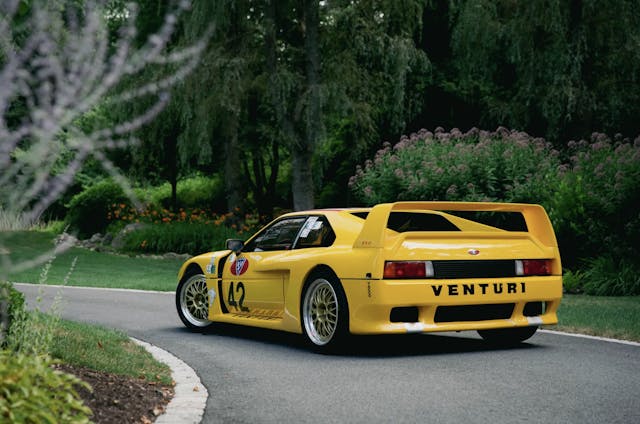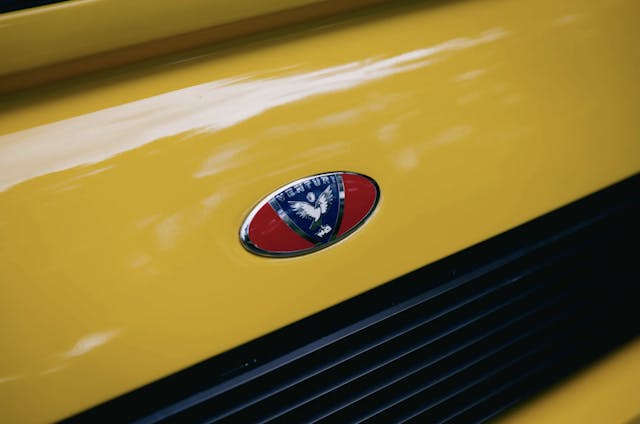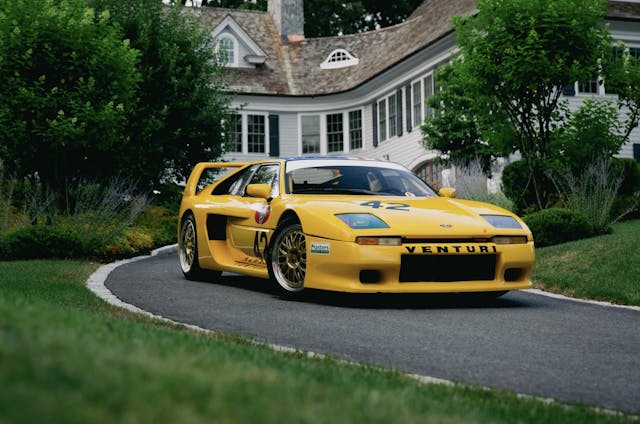Driving the Venturi 400 Trophy, France’s rare and violent ’90s exotic
The Connecticut countryside feels almost unnervingly normal. Neatly manicured landscape, tree-lined roads. At some point, I spot someone loading up a Grand Wagoneer for soccer practice.
I, on the other hand, am doing something abnormal—loading up the throttle on a twin-turbo, mid-engined French race car from the 1990s. Yes, French. And, yes, I really mean a race car; not a soft, stickered replica or some production-primed track-ready road car. The 1993 Venturi 400 Trophy bucks ye olde “race car for the road” cliché—this is a race car on the road. And they are, for the moment, ridiculously cheap. Relatively speaking, anyway.

If you’re a Yank, this might be the first time you’ve thought of Venturi in a long while—or maybe ever. No surprise, considering no Venturi was ever sold on our shores in any official capacity, and more than two decades have passed since any serious production effort was made under the Venturi “V.” The marque lives on as a Formula E race team and chaser of electric vehicle world records, but the company that birthed the 400 Trophy is long gone.
That’s a shame. On mainland Europe, Venturi made a name for itself in the late 1980s through the late 1990s with a varied portfolio of performance GTs, offering a genuinely compelling (if very French) alternative to hotness from Aston Martin, Porsche, and Maserati. Founded by two engineers under the wonderfully pragmatic Manufacture de Voitures de Sport (Sports Car Manufacture) banner, most roadbound Venturis are well-appointed mid-engine sports cars that focus more on speedy trans-alpine cruises than apical dominance on a circuit.

“So few of these cars exist outside of France, and France is already its own little bubble. So, a lot of people just don’t know about it,” explains Matthew Ivanhoe, owner of the Connecticut-based The Cultivated Collector and owner/seller of this Venturi.
As a result, Venturi occupies a rare blind spot in a 1990s-obsessed market. Standard production examples trade between $30,000 and $75,000. That is, if you can find one; not a single Venturi has graced the block of Mecum, Gooding & Co., Barrett-Jackson, Bonhams or even U.K.-based Collecting Cars. Only RM Sotheby’s presents a selling record, having sold two Venturis in Europe. Bring a Trailer, ever the haven of automotive obscura, has only a single Venturi in its archives—a gorgeous dark blue 400 Trophy that failed to sell in June 2021.
Ivanhoe describes his race-ready 400 Trophy as a kind of value proposition—a car that can be driven to the race track and then lined up against the greatest GT racing cars of the 1990s. “You’re classed with the coolest stuff. Cars like [Porsche] 3.8 RSRs, [Ferrari] F40 GTs and LMs, [Jaguar] XJ220Cs, [Mercedes-Benz] CLK GTRs, [Porsche] 911 GT1s, McLaren F1s—that level of car. And, you’re competitive with them.”

Needless to say, all the above cars go for more money than the Venturi at present. That’s understandable. Owning a Ferrari race car means something and—to be crass about it—impresses people in a way an obscure French vehicle simply won’t.
That’s not to say the 400 Trophy doesn’t have a good story to tell, and it starts with Stéphane Ratel. The man now recognized as the mastermind of modern GT racing, with several series to his name, made his bones as motorsports director of Venturi. There he launched the Gentlemen Drivers Trophy, a series featuring specially prepped Venturi 400s. Nowadays many supercar makers, including Ferrari, have such programs, but this was seldom explored territory in the early 1990s. Wealthy wannabe racers traded roughly $200,000 for a ready-to-run Venturi 400 Trophy competition car, with Venturi allegedly providing full race services, maintenance, consumables, storage, and transportation for an additional 100 Fr.

Seventy-three drivers took up the challenge over four seasons. Back when the French firm was still taking orders in the early- to mid-1990s, Venturi captured enthusiasts attention on a global scale with prominent appearances in the original Top Gear, Best Motoring, and various major car magazine tests.
Notably, Venturi also had a starring role in a certain iconic racing game. “I idolized these cars as a kid,” said Ivanhoe. “You couldn’t get Ferraris in Gran Turismo 2, and these Venturis were the closest thing.”

That might now be the best real-world sales pitch for the 400 Trophy. Most of the circa 750 Venturis produced between 1987 and 1999 were in aesthetic lock-step with the cool kids from Maranello. Under the bright summer sun in Connecticut, Ivanhoe’s 400 Trophy was all Ferrari F40. The 400’s large, integrated rectangular rear wing, sloped front nose, and squared-off rear-end drew inevitable comparisons when the car was new, and it stuck.
After you (painfully) wedge yourself into the one-piece Recaro race seats, you’re presented with a stark, no-nonsense race cockpit complete with integrated roll cage, bare Kevlar roof, and painted floors. Venturi tended to dress its production cars with glossy wood trim and enough leather to choke Louis Vuitton. That’s all gone here, replaced with greenish carbon fiber and a dash wearing a jambalaya of kill switches, warning lights, aux gauges, and controls helpfully labeled in French.
Ivanhoe takes me for a shakedown ride before he hands over the keys—or rather, before he reveals the location of the nondescript starter button. I’m warned the transmission can prove a bit tricky if I don’t shift with confidence, and that I shouldn’t ride the composite competition clutch too much on takeoff.

“You have to shift it like you’ve got balls,” Ivanhoe yells over gear whine and the ragged drone of the V-6. “Just firmly pull it into gear, like this.” He winds out second before a snap-shift to third. My breath catches, my gut compresses, and the verdant hills outside New Canaan erupt with Le Mans music.
My turn.
The clutch proves to be the most challenging bit, but only from a stop. It’s an ultra-grabby, narrow-threshold racing clutch that doesn’t like a light right foot, and as Ivanhoe both demonstrated and instructed, a standing start requires you lift off the clutch quickly, with enough throttle to keep the engine from bogging. But, it’s never enough, and you leave each stop with catastrophic brain-rattling driveline judder; I’m informed this is a feature, not a bug, and the comp-spec clutch can handle it just fine.
So can the engine. The bones of the twin-turbo buzzsaw behind my head might come from the ultra-prosaic and much-maligned PRV V-6, but this is a Jupiter-shot away from the slushy wheezers dragging the DeLorean DMC-12 and Eagle Premier/Dodge Monaco. Venturi brought the PRV to the 400-hp bleeding edge with proprietary motorsport upgrades. Performance testing back in the day netted a 0–62 mph time in the neighborhood of four seconds and a top speed around 180 mph.
That reads as rather unimpressive these days, considering that a base C8 Corvette has 490 hp and will hit 60 mph in about three seconds. But as anyone who has driven a 1960s big-block muscle car on bias-ply tires can tell you, power feels more visceral when there’s less holding it back. Pining the boost gauge on the Venturi, which lacks the suite of driver-saving technologies ubiquitous on modern sports cars, is like snipping the blue wire when you really, really should have cut the red one.

There’s some power at first, and then a few thousand up the tach, there’s everything. Shifts are similarly violent, thanks to the five-speed’s straight-cut gears. You don’t quite smash the shifter—that’s just destructive—but you’re constantly snap-shifting to avoid grinding. Do it right and the gear cracks into place like a cattle gun. Mechanical grip is ferocious, and the suspension is predictably stiff, but not quite as granite as I expected. The overall experience is frenetic, unfiltered, and dramatic in a way no modern supercar can be. The French F40, indeed.
Rippling the tarmac through quiet New England neighborhoods, engine whistling and pebbles pinging off the thin bodywork, felt as though I was leaving destruction in my wake. Like cocaine in the library or chamomile tea at the strip club, it’s all a bit weird. That doesn’t mean it wasn’t a whole heap of fun, too.

The thing is, Venturi planned it like this; at the end of the race season, owners had the option to have their race car prepped for street use, a brief service that simply added a speedometer, odometer, plastic door cards, and some carpets.
It’s rumored only 13 owners performed this upgrade. The rest of the 400 Trophies either entered storage or continued racing, where they remain fixtures on the vintage racing circuit. It’s no wonder, as the 400 Trophy is also relatively thrifty to keep on the road and/or track. Mechanical components are off-the-shelf race hardware, so fittings, hoses, belts, clutches, brakes, and filters are stuff any standard race shop could service.

At the time of publication, this yellow Venturi is on offer from The Cultivated Collector for $250,000. A skeptic might call that a hefty chunk of change for a car that, for most Americans, is the proverbial tree that fell in the woods with no one there to hear it. Of course, skeptics once said similar things about the Jaguar XJ220 and XJR-15, which can now go for $500,000 and $1M respectively. (Ivanhoe, not coincidentally, was an early champion of those cars.)
You know how you missed the boat on those other supercars, and how you wish you could go back in time and get ahead of the curve? Ah, hello. This could be that chance.
Check out the Hagerty Media homepage so you don’t miss a single story, or better yet, bookmark it.


